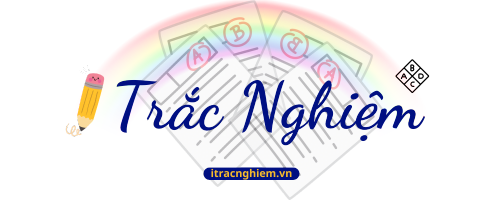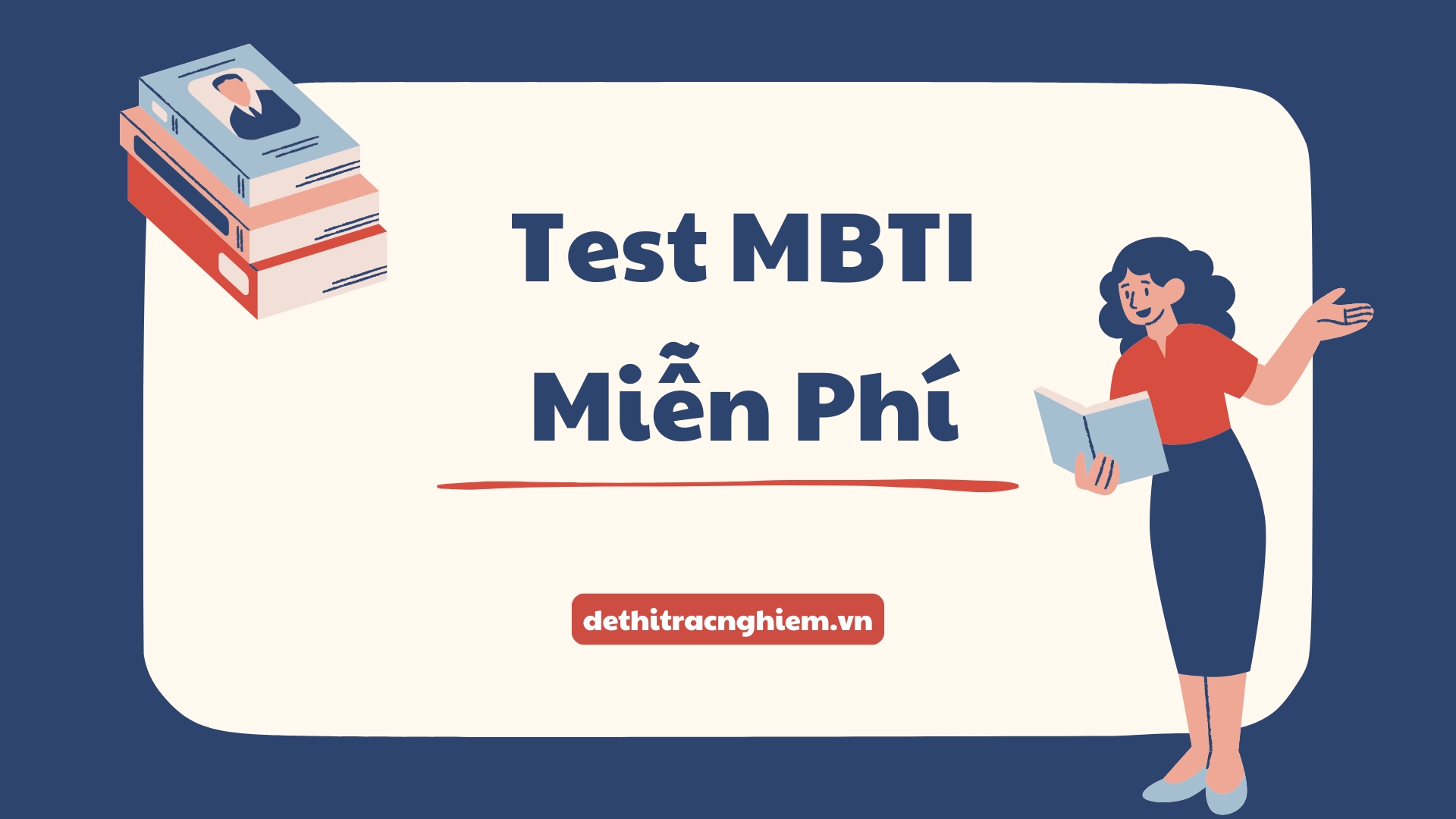Đề thi thử Đại học 2025 môn Tiếng Anh – Chuyên Vĩnh Phúc (Lần 1) là một trong những đề tiêu biểu thuộc Tổng hợp đề thi thử môn Tiếng Anh THPT QG, nằm trong chương trình Đề thi vào Đại học. Đây là đề thi được tổ chức lần 1 trong năm 2025 bởi Trường THPT Chuyên Vĩnh Phúc – một trong những trường chuyên có chất lượng đào tạo hàng đầu, nhằm giúp học sinh lớp 12 ôn luyện nâng cao năng lực ngôn ngữ, hướng tới kỳ thi tốt nghiệp THPT năm 2025.
Đề thi được biên soạn theo đúng cấu trúc chuẩn của Bộ GD&ĐT, bao gồm các phần: ngữ âm (phát âm – trọng âm), ngữ pháp – từ vựng nâng cao, giao tiếp tiếng Anh, đọc hiểu hai đoạn văn, cloze test (điền từ vào đoạn văn) và viết lại câu (sentence transformation). Với độ khó được thiết kế theo hướng phân hóa cao, đề thi không chỉ kiểm tra kiến thức cơ bản mà còn rèn luyện tư duy phản biện, kỹ năng đọc hiểu sâu và xử lý ngôn ngữ học thuật – phù hợp với mục tiêu thi đại học, đặc biệt là khối D và các khối có xét tuyển tiếng Anh.
Hãy cùng Dethitracnghiem.vn khám phá đề thi thử lần 1 của Trường THPT Chuyên Vĩnh Phúc và luyện tập nghiêm túc để tự tin bước vào kỳ thi THPT Quốc gia 2025 với kết quả vượt mong đợi!
- Số trang: 4 trang
- Hình thức: Trắc nghiệm
- Thời gian làm bài: 50 phút (không kể thời gian phát đề)
ĐỀ THI THỬ ĐẠI HỌC MÔN TIẾNG ANH NĂM 2025 THPT CHUYÊN VĨNH PHÚC (LẦN 1)
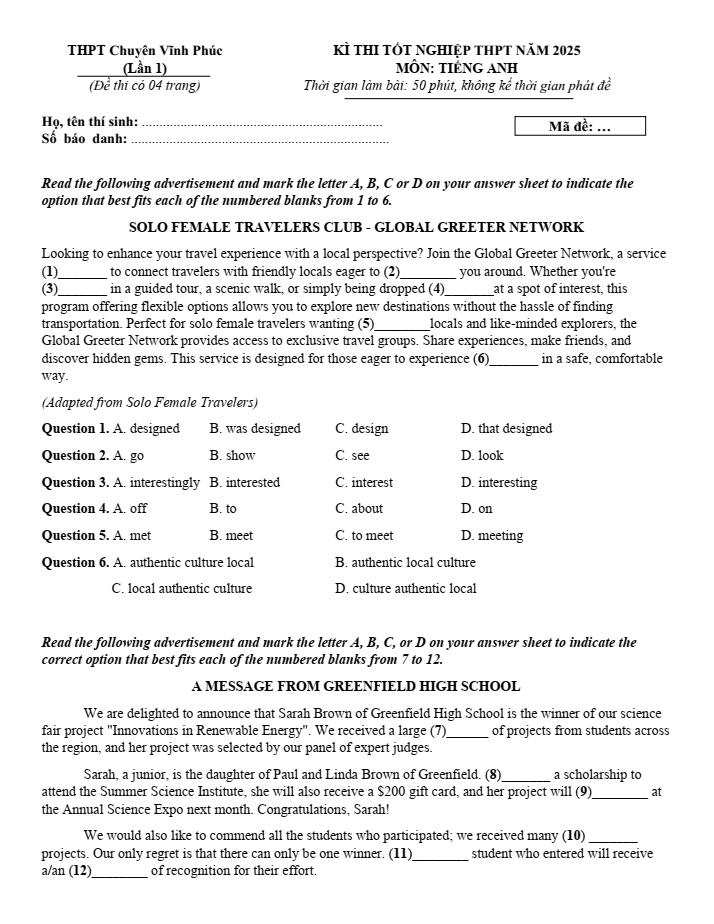

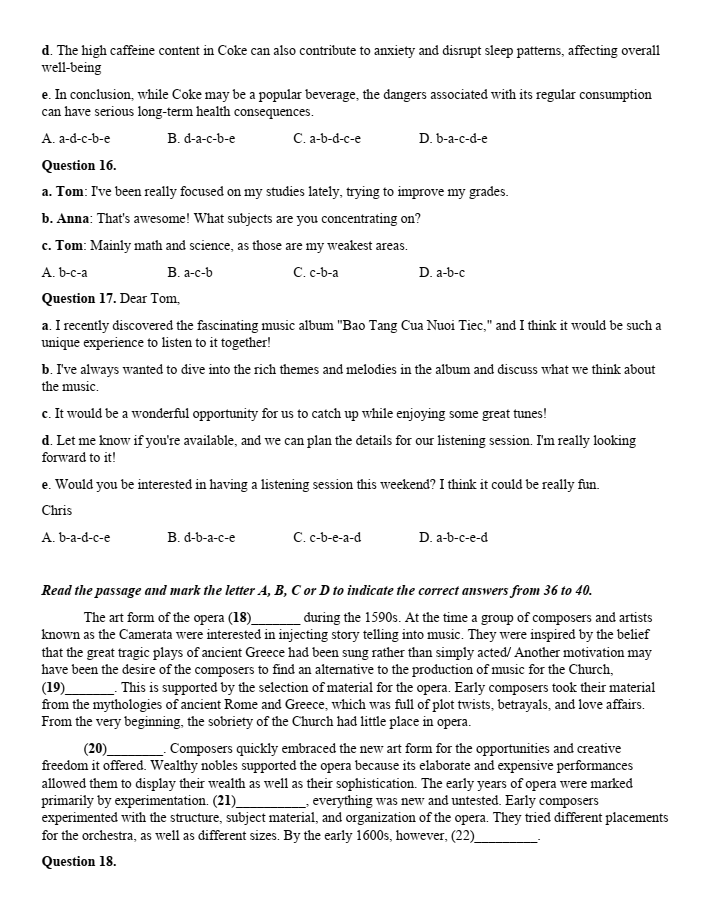
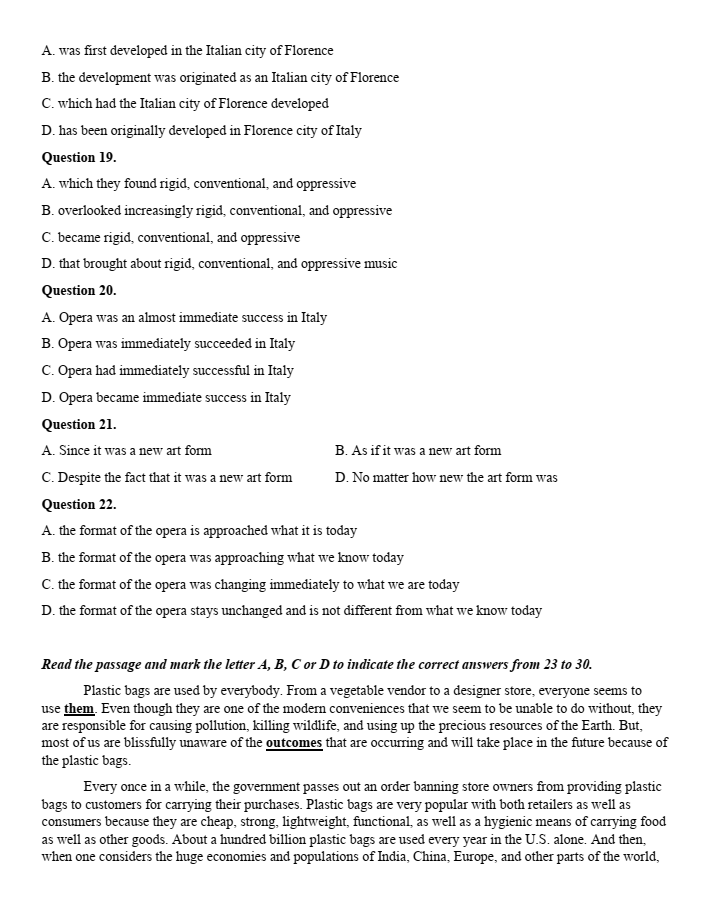
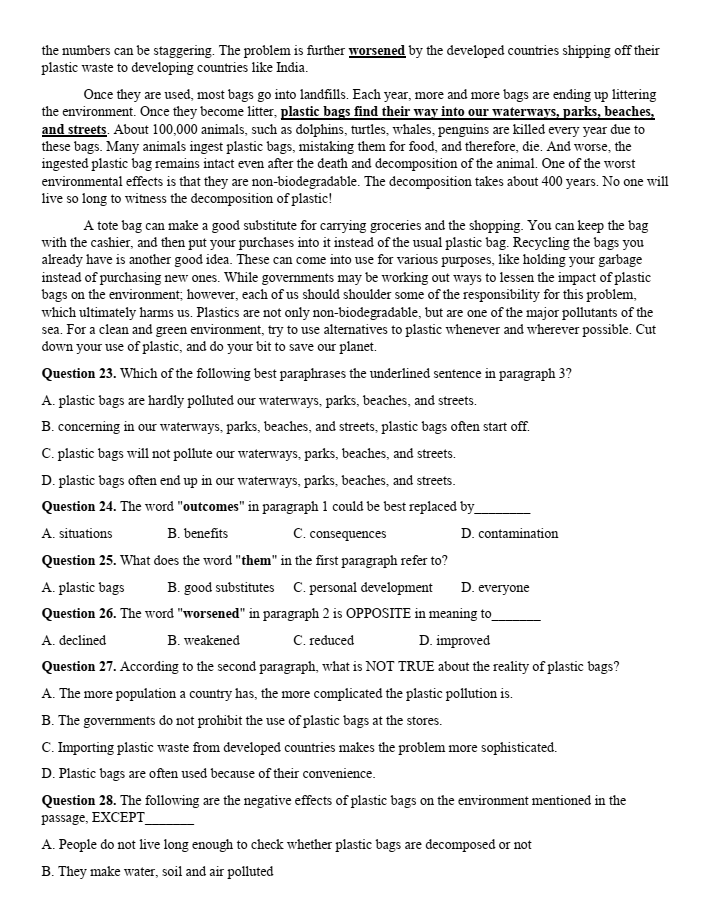
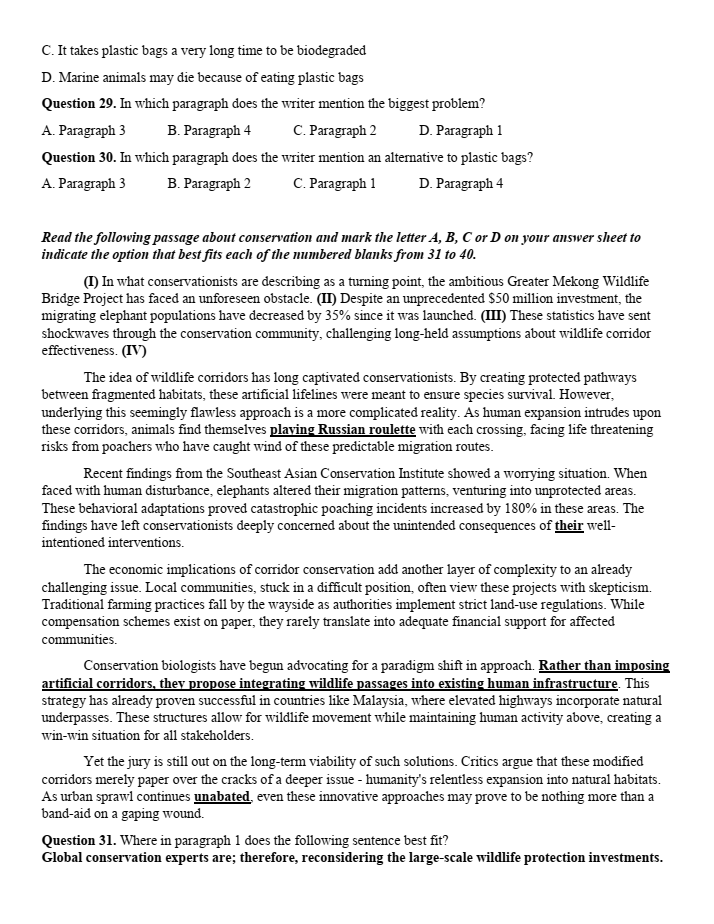
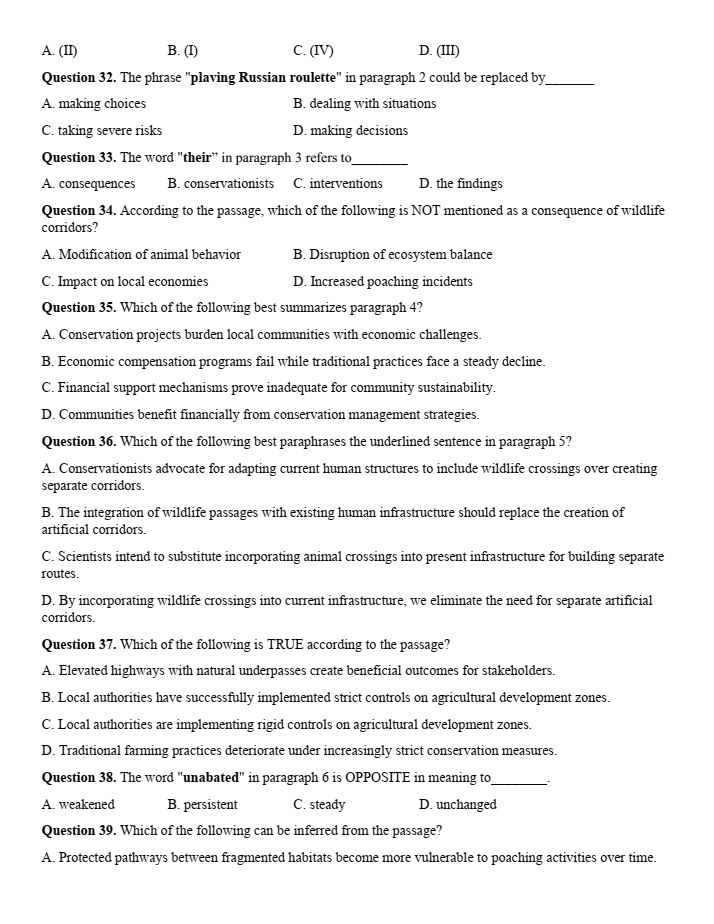
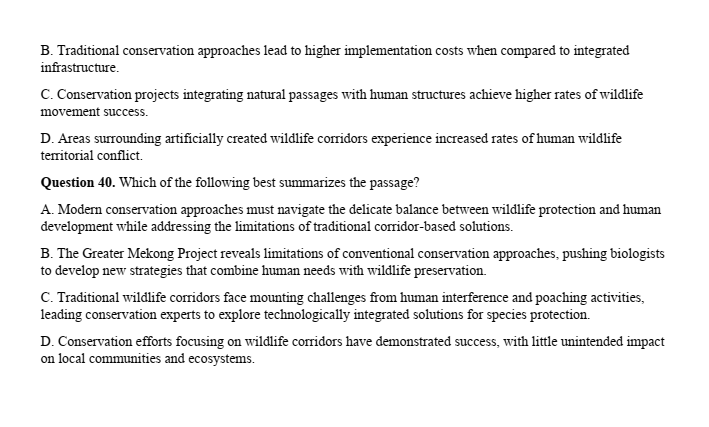
Read the following advertisement and mark the letter A, B, C or D on your answer sheet to indicate the option that best fits each of the numbered blanks from 1 to 6.
SOLO FEMALE TRAVELERS CLUB – GLOBAL GREETER NETWORK
Looking to enhance your travel experience with a local perspective? Join the Global Greeter Network, a service (1)______ to connect travelers with friendly locals, eager to (2)______ you around. Whether you’re (3)______ at a guided tour, a scenic walk, or simply being dropped (4)______ at a spot of interest, this program offers flexible options, allows you to explore new destinations without the hassle of finding transportation. Perfect for solo female travelers wanting (5)______ locals and like-minded explorers, the Global Greeter Network provides access to exclusive travel groups. Share experiences, make friends, and discover hidden gems. This service is designed for those eager to experience (6)______ in a safe, comfortable way.
(Adapted from Solo Female Travelers)
Question 1.
A. designed
B. was designed
C. design
D. that designed
Question 2.
A. go
B. show
C. see
D. look
Question 3.
A. interestingly
B. interested
C. interest
D. interesting
Question 4.
A. off
B. to
C. about
D. on
Question 5.
A. met
B. meet
C. to meet
D. meeting
Question 6.
A. authentic culture local
B. authentic local culture
C. local authentic culture
D. culture authentic local
Read the following advertisement and mark the letter A, B, C, or D on your answer sheet to indicate the correct option that best fits each of the numbered blanks from 7 to 12.
A MESSAGE FROM GREENFIELD HIGH SCHOOL
We are delighted to announce that Sarah Brown of Greenfield High School is the winner of our science fair project “Innovations in Renewable Energy”. We received a large (7)______ of projects from students across the region, and her project was selected by our panel of expert judges.
Sarah, a junior, is the daughter of Paul and Linda Brown of Greenfield. (8)______ a scholarship to attend the Summer Science Institute, she will also receive a $200 gift card, and her project will (9)______ at the Annual Science Expo next month. Congratulations, Sarah!
We would also like to commend all the students who participated; we received many (10)______ projects. Our only regret is that there can only be one winner. (11)______, student who entered will receive a/an (12)______ of recognition for their effort.
Question 7.
A. range
B. selection
C. amount
D. quality
Question 8.
A. In addition to
B. In spite of
C. With a view to
D. Because of
Question 9.
A. showcase
B. take place
C. take off
D. show off
Question 10.
A. regular
B. outstanding
C. mediocre
D. typical
Question 11.
A. Several
B. Other
C. One
D. Each
Question 12.
A. award
B. diploma
C. degree
D. mementos
Mark the letter A, B, C, or D on your answer sheet to indicate the correct arrangement of the sentence to make a meaningful paragraph/letter in each of the following Questions.
Question 13.
a. Furthermore, language that includes slurs or derogatory terms can escalate tensions and lead to online conflicts among users.
b. A recent study found that certain Vietnamese phrases used on social media are often perceived as offensive or disrespectful, particularly among younger generations.
c. This highlights the importance of promoting a positive online environment in discussions about social media etiquette.
d. In fact, research indicates that nearly 65% of social media users in Vietnam have encountered offensive language in online interactions.
e. In conclusion, being mindful of language use on social media is essential to fostering respectful communication and avoiding misunderstandings
A. e-a-d-b-c
B. b-a-d-c-e
C. b-e-a-c-d
D. d-b-c-a-e
Question 14.
a. Jason: It was such a lovely atmosphere; everyone seemed to enjoy themselves.
b. Sarah: The food was delicious too; I couldn’t get enough of the dessert table!
c. Sarah: I can’t believe how beautiful the wedding reception was!
d. Sarah: I also loved the music they chose for the first dance; it was perfect!
e. Jason: I know! The decorations were stunning and so well thought out.
A. d-b-a-e-c
B. c-e-b-a-d
C. d-e-a-b-c
D. c-b-a-e-d
Question 15.
a. Regular consumption of Coke can lead to several severe health concerns, which are linked to obesity and various health issues.
b. Studies have shown that individuals who consume soft drinks frequently are more likely to develop type 2 diabetes and heart disease.
c. Additionally, the acidity in Coke can erode tooth enamel, leading to dental problems over time.
d. The high caffeine content in Coke can also contribute to anxiety and disrupt sleep patterns, affecting overall well-being.
e. In conclusion, while Coke may be a popular beverage, the dangers associated with its regular consumption can have serious long-term health consequences.
A. a-d-c-b-e
B. d-a-c-b-e
C. a-b-d-c-e
D. b-a-c-d-e
Question 16.
a. Tom: I’ve been really focused on my studies lately, trying to improve my grades.
b. Anna: That’s awesome! What subjects are you concentrating on?
c. Tom: Mainly math and science, as those are my weakest areas.
A. b-c-a
B. a-c-b
C. c-b-a
D. a-b-c
Question 17.
Dear Tom,
a. I recently discovered the fascinating music album “Bao Tang Cua Nuoi Tiec,” and I think it would be such a unique experience to listen to it together!
b. I’ve always wanted to dive into the rich themes and melodies in the album and discuss what we think about the music.
c. It would be a wonderful opportunity for us to catch up while enjoying some great tunes!
d. Let me know if you’re available, and we can plan the details for our listening session. I’m really looking forward to it!
e. Would you be interested in having a listening session this weekend? I think it could be really fun.
Chris
A. b-a-d-c-e
B. d-b-a-c-e
C. c-b-e-a-d
D. a-b-c-e-d
Read the passage and mark the letter A, B, C or D to indicate the correct answers from 36 to 40.
The art form of the opera (18)______ during the 1500s. At the time a group of composers and artists known as the Camerata were interested in injecting story telling into music. They were inspired by the belief that the great tragic plays of ancient Greece had been sung rather than simply acted/ Another motivation may have been the desire of the composers to find an alternative to the production of music for the Church.
(19)______. This is supported by the selection of material for the opera. Early composers took their material from the mythologies of ancient Rome and Greece, which was full of plot twists, betrayals, and love affairs. From the very beginning, the sobriety of the Church had little place in opera.
(20)______. Composers quickly embraced the new art form for the opportunities and creative freedom it offered. Wealthy nobles supported the opera because its elaborate and expensive performances allowed them to display their wealth as well as their sophistication. The early years of opera were marked primarily by experimentation. (21)______, everything was new and untested. Early composers experimented with the structure, subject material, and organization of the opera. They tried different placements for the orchestra, as well as different sizes. By the early 1600s, however, (22)______.
Question 18.
A. was first developed in the Italian city of Florence
B. the development was originated as an Italian city of Florence
C. which had the Italian city of Florence developed
D. has been originally developed in Florence city of Italy
Question 19.
A. which they found rigid, conventional, and oppressive
B. overlooked increasingly rigid, conventional, and oppressive
C. became rigid, conventional, and oppressive
D. that brought about rigid, conventional, and oppressive music
Question 20.
A. Opera was an almost immediate success in Italy
B. Opera was immediately succeeded in Italy
C. Opera had immediately successful in Italy
D. Opera became immediate success in Italy
Question 21.
A. Since it was a new art form
B. As if it was a new art form
C. Despite the fact that it was a new art form
D. No matter how new the art form was
Question 22.
A. the format of the opera is approached what it is today
B. the format of the opera was approaching what we know today
C. the format of the opera was changing immediately to what we are today
D. the format of the opera stays unchanged and is not different from what we know today
Read the passage and mark the letter A, B, C or D to indicate the correct answers from 23 to 30.
Plastic bags are used by everybody. From a vegetable vendor to a designer store, everyone seems to use **them**. Even though they are one of the modern conveniences that we seem to be unable to do without, they are responsible for causing pollution, killing wildlife, and using up the precious resources of the Earth. But, most of us are blissfully unaware of the **outcomes** that are occurring and will take place in the future because of the plastic bags.
Every once in a while, the government passes out an order banning store owners from providing plastic bags to customers for carrying their purchases. Plastic bags are very popular with both retailers as well as consumers because they are cheap, strong, lightweight, functional, as well as a hygienic means of carrying food as well as other goods. About a hundred billion plastic bags are used every year in the U.S. alone. And then, when one considers the huge economies and populations of India, China, Europe, and other parts of the world, the numbers can be staggering. The problem is further **worsened** by the developed countries shipping off their plastic waste to developing countries like India.
Once they are used, most bags go into landfills. Each year, more and more bags are ending up littering the environment. Once they become litter, plastic bags find **their way into our waterways, parks, beaches, and streets**. About 100,000 animals, such as dolphins, turtles, whales, penguins are killed every year due to these bags. Many animals ingest plastic bags, mistaking them for food, and therefore, die. And worse, the ingested plastic bag remains intact even after the death and decomposition of the animal. One of the worst environmental effects is that they are non-biodegradable. The decomposition takes about 400 years. No one will live so long to witness the decomposition of plastic!
A tote bag can make a good substitute for carrying groceries and the shopping. You can keep the bag with the cashier, and then put your purchases into it instead of the usual plastic bag. Recycling the bags you already have is another good idea. These can come into use for various purposes, like holding your garbage instead of purchasing new ones. While governments may be working out ways to lessen the impact of plastic bags on the environment; however, each of us should shoulder some of the responsibility for this problem, which ultimately harms us. Plastics are not only non-biodegradable, but are one of the major pollutants of the sea. For a clean and green environment, try to use alternatives to plastic whenever and wherever possible. Cut down your use of plastic, and do your bit to save our planet.
Question 23. Which of the following best paraphrases the underlined sentence in paragraph 3?
A. plastic bags are hardly polluted our waterways, parks, beaches, and streets.
B. Concerning in our waterways, parks, beaches, and streets, plastic bags often start off.
C. plastic bags will not pollute our waterways, parks, beaches, and streets.
D. plastic bags often end up in our waterways, parks, beaches, and streets.
Question 24. The word “**outcomes**” in paragraph 1 could be best replaced by______.
A. situations
B. benefits
C. consequences
D. contamination
Question 25. What does the word “**them**” in the first paragraph refer to?
A. plastic bags
B. good substitutes
C. personal development
D. everyone
Question 26. The word “**worsened**” in paragraph 2 is OPPOSITE in meaning to______.
A. declined
B. weakened
C. reduced
D. improved
Question 27. According to the second paragraph, what is NOT TRUE about the reality of plastic bags?
A. The more population a country has, the more complicated the plastic pollution is.
B. The governments do not prohibit the use of plastic bags at the stores.
C. Importing plastic waste from developed countries makes the problem more sophisticated.
D. Plastic bags are often used because of their convenience.
Question 28. The following are the negative effects of plastic bags on the environment mentioned in the passage, EXCEPT______.
A. People do not live long enough to check whether plastic bags are decomposed or not
B. They make water, soil and air polluted
C. It takes plastic bags a very long time to be biodegraded
D. Marine animals may die because of eating plastic bags
Question 29. In which paragraph does the writer mention the biggest problem?
A. Paragraph 3
B. Paragraph 4
C. Paragraph 2
D. Paragraph 1
Question 30. In which paragraph does the writer mention an alternative to plastic bags?
A. Paragraph 3
B. Paragraph 2
C. Paragraph 1
D. Paragraph 4
Read the following passage about conservation and mark the letter A, B, C or D on your answer sheet to indicate the option that best fits each of the numbered blanks from 31 to 40.
(I) In what conservationists are describing as a turning point, the ambitious Greater Mekong Wildlife Bridge Project has faced an unforeseen obstacle. (II) Despite an unprecedented $50 million investment, the migrating elephant populations have decreased by 35% since it was launched. (III) These statistics have sent shockwaves through the conservation community, challenging long-held assumptions about wildlife corridor effectiveness. (IV)
The idea of wildlife corridors has long captivated conservationists. By creating protected pathways between fragmented habitats, these artificial lifelines were meant to ensure species survival. However, underlying this seemingly flawless approach is a more complicated reality. As human expansion intrudes upon these corridors, animals find themselves **playing Russian roulette** with each crossing, facing life threatening risks from poachers who have caught wind of these predictable migration routes.
Recent findings from the Southeast Asian Conservation Institute showed a worrying situation. When faced with human disturbance, elephants altered their migration patterns, venturing into unprotected areas. These behavioral adaptations proved catastrophic: poaching incidents increased by 180% in these areas. The findings have left conservationists deeply concerned about the unintended consequences of **their** well-intentioned interventions.
The economic implications of corridor conservation add another layer of complexity to an already challenging issue. Local communities, stuck in a difficult position, often view these projects with skepticism. Traditional farming practices fall by the wayside as authorities implement strict land-use regulations. While compensation schemes exist on paper, they rarely translate into adequate financial support for affected communities.
Conservation biologists have begun advocating for a paradigm shift in approach. **Rather than imposing artificial corridors, they propose integrating wildlife passages into existing human infrastructure.** This strategy has already proven successful in countries like Malaysia, where elevated highways incorporate natural underpasses. These structures allow for wildlife movement while maintaining human activity above, creating a win-win situation for all stakeholders.
Yet the jury is still out on the long-term viability of such solutions. Critics argue that these modified corridors merely paper over the cracks of a deeper issue – humanity’s relentless expansion into natural habitats. As urban sprawl continues **unabated**, even these innovative approaches may prove to be nothing more than a band-aid on a gaping wound.
Question 31. Where in paragraph 1 does the following sentence best fit? Global conservation experts are, therefore, reconsidering the large-scale wildlife protection investments.
A. (II)
B. (I)
C. (IV)
D. (III)
Question 32. The phrase “**playing Russian roulette**” in paragraph 2 could be replaced by______.
A. making choices
B. taking severe risks
C. making decisions
D. being with situations
Question 33. The word “**their**” in paragraph 3 refers to______.
A. consequences
B. conservationists
C. interventions
D. the findings
Question 34. According to the passage, which of the following is NOT mentioned as a consequence of wildlife corridors?
A. Modification of animal behavior
B. Disruption of ecosystem balance
C. Impact on local economies
D. Increased poaching incidents
Question 35. Which of the following best summarizes paragraph 4?
A. Conservation projects burden local communities with economic challenges.
B. Economic compensation programs fail while traditional practices face a steady decline.
C. Financial support mechanisms prove inadequate for community sustainability.
D. Communities benefit financially from conservation management strategies.
Question 36. Which of the following best paraphrases the underlined sentence in paragraph 5?
Rather than imposing artificial corridors, they propose integrating wildlife passages into existing human infrastructure.
A. Conservationists advocate for adapting current human structures to include wildlife crossings over creating separate corridors.
B. The integration of wildlife passages with existing human infrastructure should replace the creation of artificial corridors.
C. Scientists intend to substitute incorporating animal crossings into present infrastructure for building separate routes.
D. By incorporating wildlife crossings into current infrastructure, we eliminate the need for separate artificial corridors.
Question 37. Which of the following is TRUE according to the passage?
A. Elevated highways with natural underpasses create beneficial outcomes for stakeholders.
B. Local authorities have successfully implemented strict controls on agricultural development zones.
C. Local authorities are implementing rigid controls on agricultural development zones.
D. Traditional farming practices deteriorate under increasingly strict conservation measures.
Question 38. The word “**unabated**” in paragraph 6 is OPPOSITE in meaning to ______.
A. weakened
B. persistent
C. steady
D. unchanged
Question 39. Which of the following can be inferred from the passage?
A. Protected pathways between fragmented habitats become more vulnerable to poaching activities over time.
B. Traditional conservation approaches lead to higher implementation costs when compared to integrated infrastructure.
C. Conservation projects integrating natural passages with human structures achieve higher rates of wildlife movement success.
D. Areas surrounding artificially created wildlife corridors experience increased rates of human wildlife territorial conflict.
Question 40. Which of the following best summarizes the passage?
A. Modern conservation approaches must navigate the delicate balance between wildlife protection and human development while addressing the limitations of traditional corridor-based solutions.
B. The Greater Mekong Project reveals limitations of conventional conservation approaches, pushing biologists to develop new strategies that combine human needs with wildlife preservation.
C. Traditional wildlife corridors face mounting challenges from human interference and poaching activities, leading conservation experts to explore technologically integrated solutions for species protection.
D. Conservation efforts focusing on wildlife corridors have demonstrated success, with little unintended impact on local communities and ecosystems.
Mục đích tổ chức kỳ thi Đại học năm 2025 là gì?
Căn cứ theo quy chế hiện hành của Bộ Giáo dục và Đào tạo và các văn bản hướng dẫn tổ chức kỳ thi Đại học năm 2025, mục đích của kỳ thi là:
– Đánh giá kết quả học tập của học sinh sau 12 năm học theo yêu cầu của chương trình giáo dục phổ thông.
– Lấy kết quả thi để xét công nhận tốt nghiệp trung học phổ thông và làm căn cứ tuyển sinh đại học, cao đẳng.
– Góp phần đánh giá chất lượng giáo dục của địa phương và cả nước, làm cơ sở điều chỉnh nội dung, phương pháp dạy học trong nhà trường.
Thí sinh thi Đại học năm 2025 có bắt buộc thi môn Tiếng Anh không?
Theo quy định hiện hành của Bộ Giáo dục và Đào tạo và hướng dẫn tổ chức kỳ thi tốt nghiệp Đại học năm 2025, thí sinh dự thi phải thực hiện như sau:
– Thi 3 môn bắt buộc: Toán, Ngữ văn và Ngoại ngữ.
– Ngoài ra, thí sinh phải chọn một trong hai bài thi tổ hợp: Khoa học Tự nhiên (gồm các môn Vật lí, Hóa học, Sinh học) hoặc Khoa học Xã hội (gồm các môn Lịch sử, Địa lí, Giáo dục công dân – dành cho học sinh học chương trình giáo dục phổ thông).
Trong số các môn thi, Tiếng Anh là một trong ba môn thuộc bài thi Ngoại ngữ bắt buộc, thí sinh phải thi môn Tiếng Anh như một môn bắt buộc, không phụ thuộc vào lựa chọn bài thi tổ hợp hay mục đích xét tuyển đại học.
Như vậy, kỳ thi Đại học năm 2025 bắt buộc thí sinh phải thi môn Tiếng Anh.
